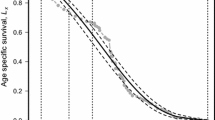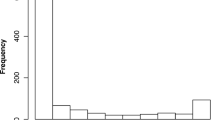Abstract
Management strategies for urban and stored-product pests are chosen for a variety of attributes including cost, efficacy, and human safety. Insect growth regulators, which are low-risk alternatives to traditional neurotoxic insecticides, may be valuable management options. However, as these new products become available there is a need to determine efficacy in regard to survival after exposure and effect on population dynamics, so that overall value of these treatment methods can be determined. This study was conducted to predict the effects of methoprene and two conventional insecticides combined with methoprene on development of Plodia interpunctella Hübner populations on an optimal diet and on a suboptimal diet. Effects on populations were simulated using a modified temperature-based growth model at 24, 30, and 35 °C, and the effects of timing and frequency of insecticide treatments were determined. The results of this simulation study predict rapid population growth of P. interpunctella populations on optimal and suboptimal diets, and that single applications of a contact insecticide or aerosol may not be sufficient to manage P. interpunctella populations over a 6-month period.








Similar content being viewed by others
References
Arbogast RT (2007) A wild strain of Plodia interpunctella (Hübner) (Lepidoptera: Pyralidae) from farm-stored maize in South Carolina: effect of temperature on mating, survival, and fecundity. J Stored Prod Res 43:503–507
Arthur FH (2008) Aerosol distribution and efficacy in a commercial food warehouse. Insect Sci 15:133–140
Arthur FH (2010) Residual efficacy of aerosols to control Tribolium castaneum and Tribolium confusum. In: Carvalho MO et al (eds) Proceedings of the 10th international working conference on stored product protection. Estoril, Portugal, pp 791–798
Bjornstad ON, Begon M, Stenseth NC, Wilhelm F, Sait SM, Thompson DJ (1998) Population dynamics of the Indianmeal moth: demographic stochasticity and delayed regulatory mechanisms. J Animal Ecol 67:110–126
Fields PG, White NDG (2002) Alternatives to methyl bromide treatments for stored-product and quarantine insects. Ann Rev Entomol 47:331–359
Fontenot EA, Arthur FH, Nechols JR, Throne JE (2012) Using a population growth model to simulate response of Plodia interpunctella Hübner to temperature and diet. J Pest Sci 85:163–167
Hilton SJ, Banks HJ (1997) Methyl bromide sorption and residues on sultanas and raisins. J Stored Prod Res 33:231–249
Jenson EA, Arthur FH, Nechols JR (2009) Efficacy of methoprene applied at different temperatures and rates on surface substrates to control eggs and fifth instars of Plodia interpunctella. J Econ Entomol 102:1992–2002
Jenson EA, Arthur FH, Nechols JR (2010a) Efficacy of an esfenvalerate plus methoprene aerosol for the control of eggs and fifth instars of Plodia interpunctella (Lepidoptera: Pyralidae). Insect Sci 17:21–28
Jenson EA, Arthur FH, Nechols JR (2010b) Methoprene and synergized pyrethrins as an aerosol treatment to control Plodia interpunctella (Hübner), the Indianmeal moth (Lepidoptera: Pyralidae). J Stored Prod Res 46:103–110
Johnson JA (2007) Survival of Indianmeal moth and navel orangeworm (Lepidoptera: Pyralidae) at low temperatures. J Econ Entomol 100:1482–1488
Johnson JA, Vail PV (1989) Damage to raisins, almond and walnuts by irradiated Indianmeal moth and navel orangeworm larvae (Lepidoptera: Pyralidae). J Econ Entomol 82:1391–1394
Johnson JA, Wofford PL, Gill RF (1995) Developmental thresholds and degree-day accumulations of Indianmeal moth (Lepidoptera: Pyralidae) on dried fruits and nuts. J Econ Entomol 88:734–742
Johnson JA, Vail PV, Brandl DG, Tebbets JS, Valero KA (2002) Integration of nonchemical treatments for control of post-harvest Pyralid moths (Lepidoptera: Pyralidae) in almonds and raisins. J Econ Entomol 95:190–199
Kaliyan N, Carrillo MA, Morey RV, Wilcke WF, Kells SA (2007a) Mortality of Indianmeal moth (Lepidoptera: Pyralidae) populations under fluctuating low temperatures: model development and validation. Environ Entomol 36:1318–1327
Kaliyan N, Morey RV, Wilcke WF, Carrillo MA, Cannon CA (2007b) Low-temperature aeration to control Indianmeal moth, Plodia interpunctella (Hübner), in stored grain in twelve locations in the United States: a simulation study. J Stored Prod Res 43:177–192
Longstaff BC (1988) Temperature manipulation and the management of insecticide resistance in stored grain pests: a simulation study for the rice weevil, Sitophilus oryzae. Ecol Model 43:303–313
Mahroof R, Subramanyam B (2006) Susceptibility of Plodia interpunctella (Lepidoptera: Pyralidae) developmental stages to high temperatures used during structural heat treatments. Bull Entomol Res 96:539–545
Mason LJ, Rulon RA, Maier DE (1997) Chilled versus ambient aeration and fumigation of stored popcorn, part 2: pest management. J Stored Prod Res 33:51–58
Mohandass S, Arthur FH, Zhu KY, Throne JE (2007) Biology and management of Plodia interpunctella (Lepidoptera: Pyralidae) in stored products. J Stored Prod Res 43:302–311
Mullen MA (1994) Rapid determination of the effectiveness of insect resistant packaging. J Stored Prod Res 30:95–97
Roesli R, Subramanyam Bh, Fairchild FJ, Behnke KC (2003) Trap catches of stored-product insects before and after heat treatment in a pilot feed mill. J Stored Prod Res 39:521–540
Sinclair ER, Alder J (1985) Development of a computer simulation model of stored product insect populations on grain farms. Agricult Syst 18:95–113
Throne JE (1989) Effects of noncatastrophic control technologies that alter life history parameters on insect population growth: a simulation study. Environ Entomol 18:1050–1055
Throne JE (1995) Computer modeling of the population dynamics of stored-product pests. In: Jayas DS, White NDG, Muir WE (eds) Stored-grain ecosystems. Marcel Dekker Inc., New York, pp 169–195
Throne JE, Arbogast RT (2010) A computer model for simulating population development of the Indianmeal moth (Lepidoptera: Pyralidae) in stored corn. J Econ Entomol 103:1503–1507
Vail PV, Tebbets JS, Cowan DC, Jenner KE (1991) Efficacy and persistence of a granulosis virus against infestations of Plodia interpunctella (Hübner) (Lepidoptera: Pyralidae) on raisins. J Stored Prod Res 27:103–107
Acknowledgments
We thank J. A. Johnson for reviewing a draft of this manuscript prior to submission. Mention of trade names or commercial products in this publication is solely for the purpose of providing specific information and does not imply recommendation or endorsement by the U.S. Department of Agriculture or by Kansas State University. The USDA is an equal opportunity provider and employer. This study was supported by the USDA/CSREES Risk Avoidance and Mitigation Program Award No. 00-511-01-9674. This paper is contribution no. 12-101-J from the Kansas Agricultural Experiment Station.
Author information
Authors and Affiliations
Corresponding author
Additional information
Communicated by K. J. Gorman.
Rights and permissions
About this article
Cite this article
Fontenot, E.A., Arthur, F.H., Nechols, J.R. et al. Using a population growth model to simulate response of Plodia interpunctella Hübner populations to timing and frequency of insecticide treatments. J Pest Sci 85, 469–476 (2012). https://doi.org/10.1007/s10340-012-0436-z
Received:
Accepted:
Published:
Issue Date:
DOI: https://doi.org/10.1007/s10340-012-0436-z




